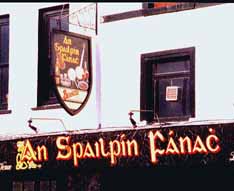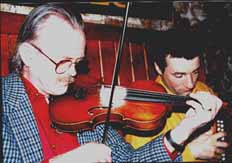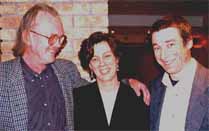 Seán Laffey wanders into the Spailpín Fanach for an evening's session with Séamus Creagh and Aidan Coffey.
Seán Laffey wanders into the Spailpín Fanach for an evening's session with Séamus Creagh and Aidan Coffey.
A FolkWorld article by Sean Laffey
 Seán Laffey wanders into the Spailpín Fanach for an evening's session with Séamus Creagh and Aidan Coffey.
Seán Laffey wanders into the Spailpín Fanach for an evening's session with Séamus Creagh and Aidan Coffey.
I met Aidan, Séamus and his wife Marie-Annik Desplanques at their regular Tuesday night session in the Spailpin Fanach, across the road from the Beamish brewery. Both establishments date back to the early 1790's. The session takes place in the brick walled snug to the left of the bar, and snug it is too, a small fire warms the space, it has it's own metre and a half of bar. This has been their regular session for over eight years and it showed in the way they effortlessly relaxed into a night of music, Séamus on fiddle, Aidan on box and Marie-Annik playing a very sensitive accompaniment on guitar.
In that snug little bar there were three very interesting stories, weaving there way in and out of the music, all of the players "blow ins" to Cork, a City and County famous for its welcome and a place where in-comers are beguiled by the native way of doing things. And so it has been for Séamus and Aidan. They both hail from farming backgrounds and each claims to have had very little music in the home. Séamus has said "I often wonder if I was a changeling, nobody in our house smoked, drank or made music."
 Aidan Coffey, is sixteen years younger than Séamus, he is a native of Bunmahon Co. Waterford. There was no music in the house, but those were the days of great traditional music on the radio and even in his first year of life he was animated by the music. Much later he was to teach himself box, bagpipes and uilleann pipes, if the music is in you, you had better buy an instrument to bring it out. In Waterford he played a mainly standard repertoire although there were Waterford polka sets in Ballymacarbry, Tooraneena and Dugarvan (lovely country , the roads from Clonmel to Dungarvan or Youghal will bring you through this lush hilly land scratched with small rivers and dotted with three pub villages).
Aidan Coffey, is sixteen years younger than Séamus, he is a native of Bunmahon Co. Waterford. There was no music in the house, but those were the days of great traditional music on the radio and even in his first year of life he was animated by the music. Much later he was to teach himself box, bagpipes and uilleann pipes, if the music is in you, you had better buy an instrument to bring it out. In Waterford he played a mainly standard repertoire although there were Waterford polka sets in Ballymacarbry, Tooraneena and Dugarvan (lovely country , the roads from Clonmel to Dungarvan or Youghal will bring you through this lush hilly land scratched with small rivers and dotted with three pub villages).
Aidan 's early playing, whether for dances or socially at Fleadhs was more often in the company of older musicians something which has added immeasurably to his understanding of and respect for the tradition. In I981 Aidan attended UCC as a microbiology undergraduate ("I eventually went all the way, got a PhD and all that" he modestly told me). The scene in Cork at the time was buzzing, there were lots of young musicians in the town and active older ones too. "My landlord was a fiddle payer and he'd take me to sessions in the Áras on the Mardyke. Music was just a hobby for me at the time, I had joined Michel O'Súilleabháin's Traditional Music society at UCC, but like the other three or four members we had no intention of doing this professionally, most of us weren't eve doing a BMus degree."
At this time Aidan switched from the B/C accordion to the C#/D system which he says "gives me a more fluid rhythm." There was a necessary period of adjustment as he came to grips with the new fingering, but he learns fast. And he needed to when he joined DeDannan in 1988. He stayed with the band six years before he went off to Holland as a Post Doctoral researcher. Playing with the DeDannan as a student must have been a great experience? " I play maybe ten weeks of the year with them, you'd get a call from Frankie to say we had a weekend gig in Vancouver, and it was a case of pack your bags, play and come back to Cork for your studies on the Monday morning." So unlike his present arrangement with Séamus where years of paying allow the tunes to develop, I take it things were far more frenetic with DeDannan. " Sure, especially during the recordings, we might work out a new tune in the morning, have an hour to practice it and then put on tape the same day."
 There's a hint of the DeDannan sound on the new album, helped by Sean O Lionsigh's round backed bouzouki. Great tunes too and very extensive liner notes, I asked Séamus had he done all the research himself? " The bulk of that is down to Paul De Grae." So you don't raid the old collections for tunes and hunt out unusual selections ? "Most of our tunes we have from other payers, sessions are great for sharing tunes," Aidan comes in "Yes, back in the 80's when I was the University, the young musicians would buy as many new CDs as they could, just to pick up these new tunes, and it still goes on. Written music is important, but the tradition is essentially oral."
There's a hint of the DeDannan sound on the new album, helped by Sean O Lionsigh's round backed bouzouki. Great tunes too and very extensive liner notes, I asked Séamus had he done all the research himself? " The bulk of that is down to Paul De Grae." So you don't raid the old collections for tunes and hunt out unusual selections ? "Most of our tunes we have from other payers, sessions are great for sharing tunes," Aidan comes in "Yes, back in the 80's when I was the University, the young musicians would buy as many new CDs as they could, just to pick up these new tunes, and it still goes on. Written music is important, but the tradition is essentially oral."
Séamus was born in Killucan County Westmeath in 1946, his early musical education was an introduction to dance band violin from his neighbour Larry Ward. A brief excursion with a ballad group in Dublin where he played guitar brought him closer to the traditional fold. In the early sixties he spent many a night in O'Donoghues with Ted Furey the fiddler who was a vital bridge between the ballad and traditional scene . Then in 1967 he made trip to Baltimore in West Cork, just for a weekend, he still hasn't escaped the pull of Cork. Not that all his time has been spent in Ireland's largest county, he lived for five years in Newfoundland, I asked him had he picked up any of their tunes?
"No not really, I couldn't work them out. You see" he laughs "they were playing all these Irish tunes to Breton dancers. The two didn't really fit, you had to work the tune to fit the dance pattern, sometime you'd be playing seven bars, other times nine to what was essentially eight bar Irish music, I couldn't fathom it at all!"
 He also spent some time in London making a few shillings busking on the underground. I wondered had he ever been moved on or arrested. "I was very lucky, at the Green Park tube station I met one of the transport police he was from East Limerick and he loved the Blackbird, when he was on duty I could play for as long as I liked!"
He also spent some time in London making a few shillings busking on the underground. I wondered had he ever been moved on or arrested. "I was very lucky, at the Green Park tube station I met one of the transport police he was from East Limerick and he loved the Blackbird, when he was on duty I could play for as long as I liked!"
Back in Cork in the late sixties Séamus began playing with Jackie Daly at CCÉ sessions in the Country Club Hotel. This opened his ears to the music of Slaibh Lucra. "When I heard Jackie playing it was like nothing I heard before. There were plenty of fellas that owned boxes but very few box players."
There followed a ten year partnership that was to be marked by the 1977 Gael Linn Jackie Daly and Séamus Creagh album and introduced him to the polka repertoire of Sliabh Lucra . At first he wasn't at all keen on the polkas, he would have been playing a standard selections of jigs and reels, but playing for dancers in The Phoenix in Cork City, sessions in Baile Mhúirne and Ovens changed all that. Unlike his Canadian sojourn, here he linked the dances to the tunes and the result is his present deft and sensitive touch with the repertoire.
Finally would they ever think of forming a big band? No, they like the fiddle and box combination, there's enough space there to explore the music without over arranging it. Aidan reflects for a moment "Perhaps that is why DeDannan have lasted, at their heart they have always been a fiddle and box band. As for us I'm happy with the way Séamus and I do things, we are so lucky too that we have Seán and Marie-Annik, they know how to accompany a tune without going off on their own agendas."
 A week later at the launch of the Séamus Creagh and Aidan Coffey CD on the Ossian label, at Beamish and Crawford Brewery in Cork, Nuala O'Connor in the key note speech remarked on the vibrancy of the Sliabh Lucra. You see the music has a strong local character, it is the mother lode of slides and polkas, and the reason these have survived and prospered is that it is still very connected to dance. And their latest CD will neither tie your feet to the floor nor tire you out, it is rooted in an understanding of the music that goes beyond the accomplishment of notes.
A week later at the launch of the Séamus Creagh and Aidan Coffey CD on the Ossian label, at Beamish and Crawford Brewery in Cork, Nuala O'Connor in the key note speech remarked on the vibrancy of the Sliabh Lucra. You see the music has a strong local character, it is the mother lode of slides and polkas, and the reason these have survived and prospered is that it is still very connected to dance. And their latest CD will neither tie your feet to the floor nor tire you out, it is rooted in an understanding of the music that goes beyond the accomplishment of notes.
Photo Credit: Sean Laffey
Sean Laffey, author of this article, is the editor of the excellent monthly Irish Music Magazine, one of the best and most professional folk magazines around.
Back to the content of FolkWorld Articles & live reviews
To the content of FolkWorld online magazine Nr. 9
All material published in FolkWorld is © The Author via FolkWorld. Storage for private use is allowed and welcome. Reviews and extracts of up to 200 words may be freely quoted and reproduced, if source and author are acknowledged. For any other reproduction please ask the Editors for permission.
